If you’ve been on Twitter at all in the last half decade, then you’ve likely heard of Buffer.
The social media sharing and scheduling app has been a catalyst for a new paradigm in social media marketing. It allows users to find content or schedule messages to be shared into the future. But, to take things a step further, it also schedules that content based on algorithms that determine the best times to maximize visibility and engagement.
Some may argue that Buffer and similar apps have diluted the “social” nature social media, encouraging people to pre-schedule all of their messages and simply blast our links and promotions. That’s a discussion for another post.
No matter your feelings, Buffer exploded onto the scene as a godsend for heavy social media users and digital marketers looking for simple ways to streamline their process of managing content across an evergrowing number of social channels.
In a word, Buffer offers simplicity.

Since initially launching back in 2011, the core product has undergone a number of transformations. They expanded on the initial product to offer extended features and functionality specifically for business users.
In total, they’ve accumulated over four million users—both free and paid subscribers.
For our purposes, though, we want to understand how Buffer built such a huge footprint in a relatively short period of time. This is where it gets interesting. Much of their success has come through organic growth driven largely by content and social channels. They’ve become a case study in scrappy, content-first growth strategy for startups without a huge advertising budget.
Buffer helped usher in an increased focus on content marketing as a viable strategy for growing a successful business from the ground up.
In this teardown, we’ll analyze how Buffer was able to find huge success with content marketing and how other companies can apply the same secrets to build a proven growth strategy.
Building Buffer from Scratch
Of all the startup and SaaS growth stories in recent years, Buffer is perhaps one of the most compelling.
Not only have they built a $15MM ARR business in about 7 years, but they launched and grew their business without any funding for over a year, bootstrapping their way to about $20K MRR before raising a $400k seed round in 2011.
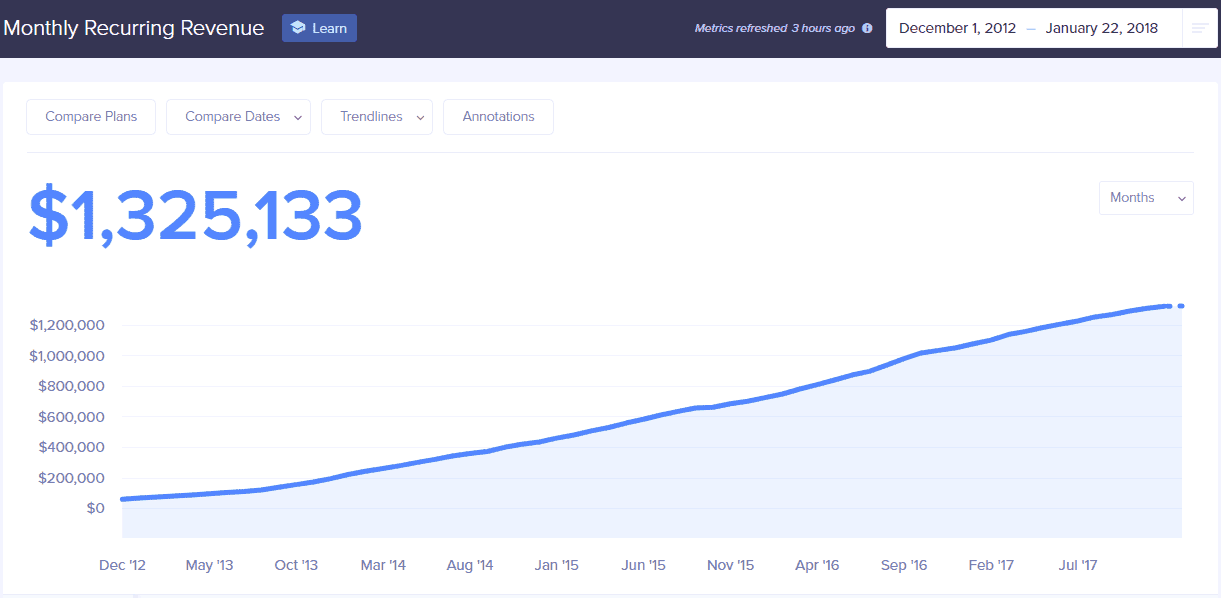
With a relatively simple product and a massive content marketing strategy, Buffer used that seed round to grow to $4.6MM in ARR and nearly 2 million users. They didn’t raise a Series A until their fourth year of existence. In 2014, they raised $3.5MM to accelerate growth and now have more than 77,000 paying customers.
Throughout the entire Buffer journey, they have used masterful content marketing as their primary user acquisition strategy, amassing an enormous following and dozens of viral articles in their back catalog.
As you may have suspected, they’ve figured out a number of excellent strategies and tactics along the way that have helped them excel with content and fueled their growth over the years. Let’s break down the different ways that Buffer has built such a wildly successful content marketing program.
CONTENT MARKETING SECRET #1
Bootstrapping Traction with Guest Posting
That initial traction phase of any company or content marketing strategy can be a bit daunting.
There’s so much to do, so much to try, and often very little results to show from the upfront work. Buffer’s strategy helped them generate immediate results and build a base of tens of thousands of users less than a year after launching.
Key to their early growth? Guest posting.
Before we get too far, I should say that the landscape has changed a bit since Buffer first launched and relied heavily on guest posting. For one, Google has cracked down on guest posting as primarily a link-building strategy. So, any links pointing back to your site could (and possibly should) be marked no-follow.
But, that doesn’t mean there’s no value in guest posting.
There is still a huge opportunity to reach new audiences and drive targeted traffic to your website with a strategic and relevant guest post on the right sites.
Buffer’s cofounders leaned heavily on this to build brand awareness and drive traffic to their website while they developed their own audience. This allowed them to get in front of their target users (marketers, small business owners, etc) without spending money on ads.
Many of Buffer’s early guest posts focused on listing social media tools for marketers, which, of course, included their own tool.
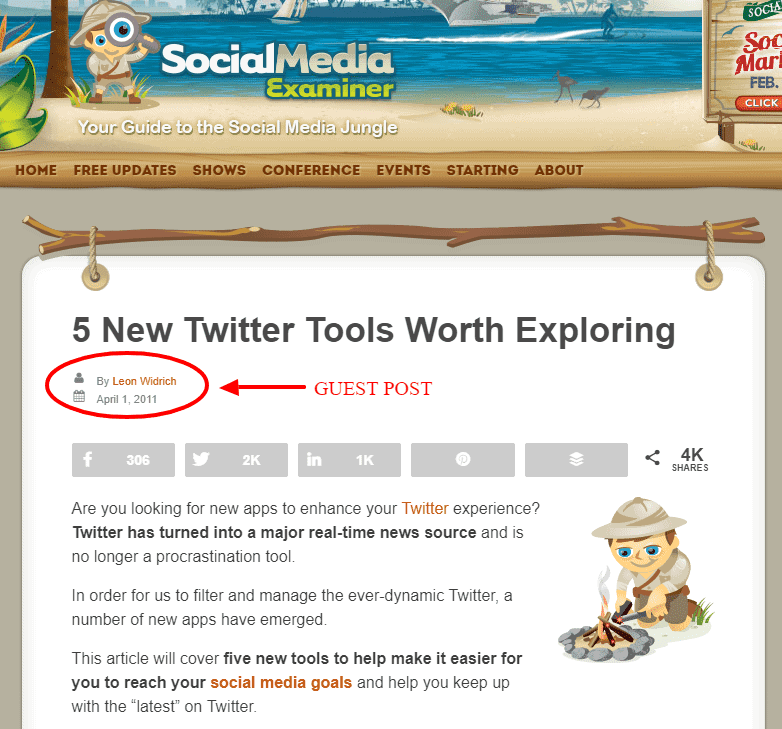
This allowed Buffer to gain some traction in the marketplace almost immediately after launch. Plus, they were able to test different approaches with only a small amount of work to see how they could best use guest posts to drive traffic and users.
CONTENT MARKETING SECRET #2
Create Next-level Content with Curation
Almost anyone who is creating content wants to create something valuable and epic.
A huge hurdle for many people is that they feel like they have nothing truly new, original, or valuable to offer. After all, how many different articles about how to run Facebook ad campaigns does the world really need?
But, here’s the secret: You don’t have to be the first nor the “best” in order to create and publish something valuable. (Mind blown!)
In fact, many companies that publish content are so consumed with cranking out their own, original articles or guides that they completely ignore the entire body of work that already exists on that subject or topic. This is a huge problem.
As a user, this trend sucks. It means that rather than really finding an “ultimate” guide to a particular topic, you have to read 5 or 6 different articles to get a full range of ideas or information. Who wants to do that?
Buffer has taken the opposite approach.
Rather than bending over backward to do something new or unique with every post, they place a lot of emphasis on providing value by sourcing and compiling the content that’s already available on that particular subject.
They use content curation as a core strategy.
One of their most successful posts of all time is on the psychology of color in marketing.
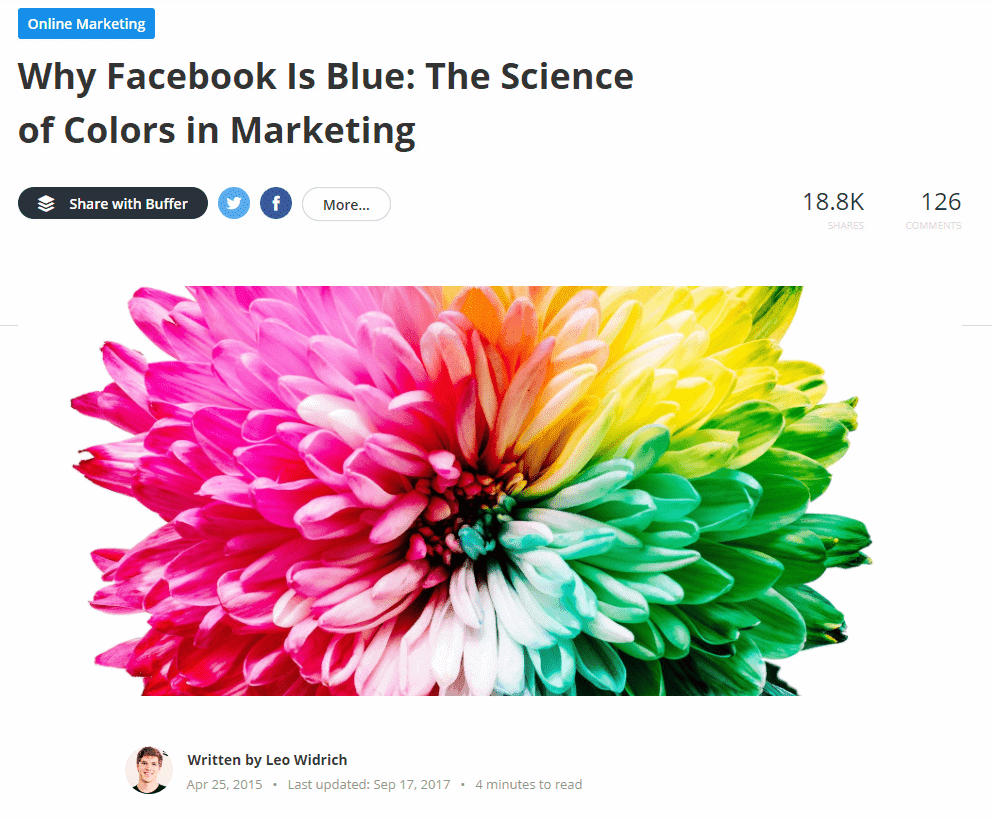
In this post, there are a lot of valuable insights about what roles different colors play in eliciting certain reactions or emotions from your target audience. It’s a treasure trove of data, insight, and ideas.
But, it’s essentially just a round-up on the available research on this topic.
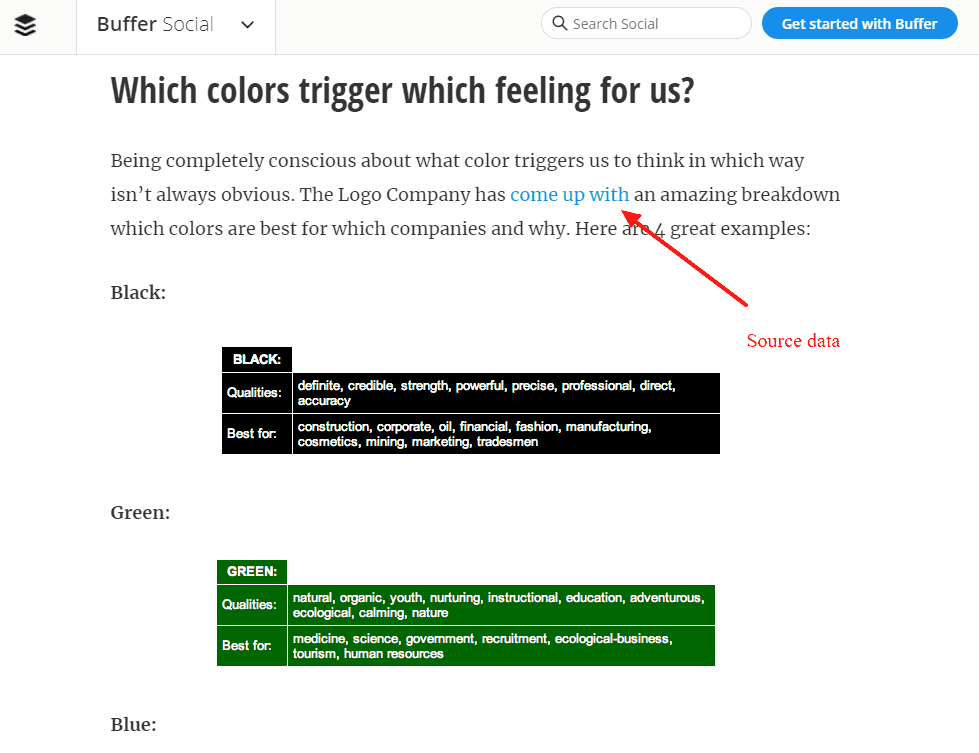
Buffer didn’t conduct any original research or have any new and unique data to share. Hell, they didn’t even bother creating an infographic or cheat sheet. Instead, they took the time to do a deep dive on this topic, surface the best available information, and then put it all in one place.
This may seem incredibly easy–almost too easy–if you’re coming from the mindset that every piece of content you create needs to be brand new and exciting in order to break through the noise. But it’s still hugely valuable (that’s why the content has been so popular).
In fact, because so much content is being created and published every single day, there are a lot of times where it just makes more sense to use what’s already out there rather than try to reinvent the wheel.
Buffer’s secret is that they focus on providing value, not stroking their own ego.
Sometimes the best value you can provide to your audience and your readers is to take the time to dig into a topic and put all of the relevant information in a single place. It’s not writing another article that rehashes the same exact topic that’s already been covered at a basic level by 20 other websites.
Curating content–research and data, especially–is a secret weapon among the world’s best content marketers.
CONTENT MARKETING SECRET #3
Advanced Social Promotion Strategies
When it comes to social sharing, Buffer has a distinct unfair advantage.
Because their product is focused on finding, curating, and sharing content on social channels, they had a number of excellent opportunities to drive increased social reach and engagement for every piece they publish.
For starters, their audience is quite likely to be social media-minded, since that’s a big part of their product marketing in the first place.
Secondly, they brilliantly use their own product as a distribution channel for the content they publish. When users are adding tweets and posts to their sharing queue, Buffer will suggest content that is relevant to that person and their audience. It should come as no surprise that Buffer’s own content is often among the suggestions.
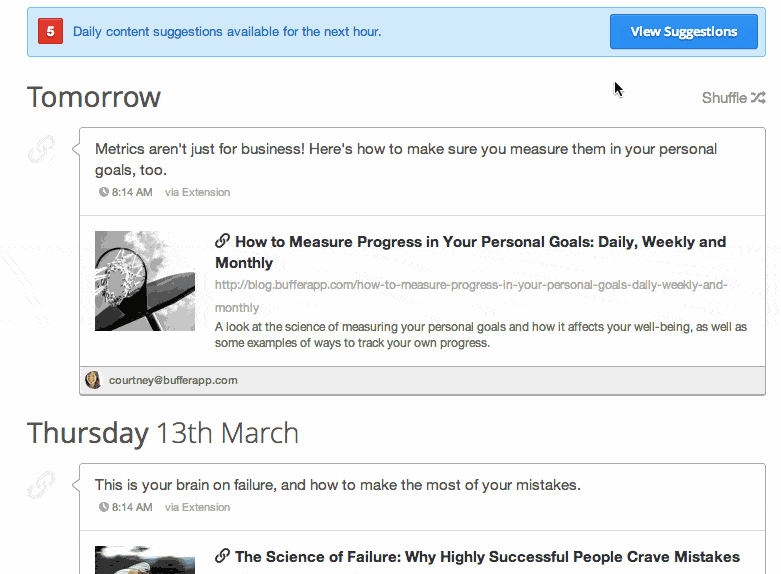
Lastly, because their product is engineered to find patterns and best practices for when and how to share content, Buffer is able to squeeze the maximum amount of engagement from every tweet, post, and share.
Now, as a reader, you may be thinking that these tactics are all exclusive to Buffer.
But we can learn a lot from their success and apply it to any content marketing strategy, regardless of whether you have the advantage of having a product that can help you build and grow your audience.
Let’s look at some key takeaways based on how Buffer uses social media as part of their content marketing strategy:
- Plan for content promotion before you begin content creation; start with the goal and work backward
- Go beyond a single share—maximize the lifespan and value of your content by developing an extended social promotion plan for every piece you publish
- Workshop the hell out of your headlines—optimize for clicks, shares, and engagement on different channels
- Write for influencers to gain extra traction and generate shares from those with a big, established audience
The point here is that although Buffer may have some extra advantages when it comes to social media promotion, that shouldn’t hold you back from learning what works.
Everyone knows that social media is a key channel for promoting and distributing content. But there’s much more beyond just tweeting and sharing articles—learn the advanced strategies that drive big engagement and more traffic to your site.
CONTENT MARKETING SECRET #4
Repurpose Assets to Drive More Traffic/Links
Buffer has mastered the art of repurposing content and optimizing it for any number of different channels.
They often take content that works as a blog post and create a series of targeted graphics for channels like Facebook and Twitter.
But that’s just the start.
To take it even a step further, they create videos from their most successful posts. Then they can use those as native video content on different channels.

In some cases, they also use Slideshare as a key channel for content distribution. By taking their blog posts and repurposing the content as a slide deck, they can reach new readers and drive a new audience back to their website.
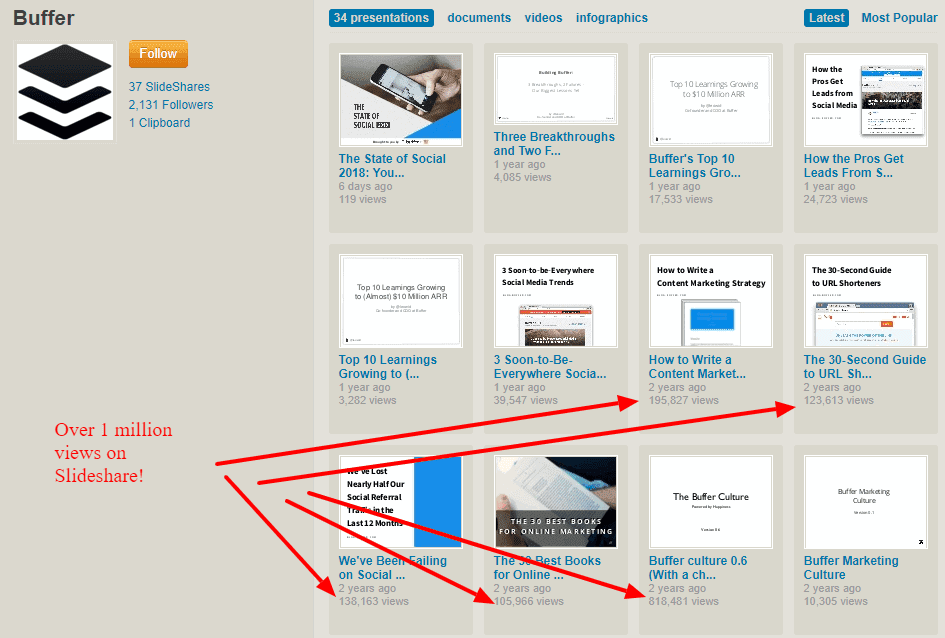
Again, we see that Buffer is borrowing an audience that exists outside of their core reach. Just like with guest posting, they can get in front of people who have never even heard of their company.
This is absolutely critical to continue to expand your content’s reach and attract new readers and users to your site.
CONTENT MARKETING SECRET #5
Transparency as a Strategy
A final secret from Buffer’s enormous success is to weaponize transparency as a marketing strategy.
As a matter of policy, Buffer has vowed to share all kinds of information about their business. From salaries to growth metrics and vacation policies—they’ve put it all out there for anyone to read.
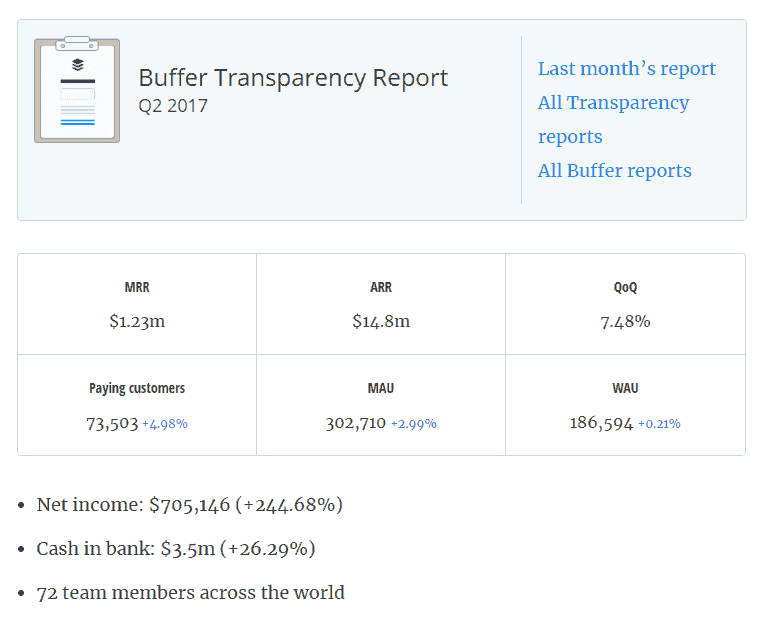
On its face, this may just seem like a cool gesture of goodwill that helps them stay engaged and accountable.
But, consider this: One of the key audiences for the Buffer product is startup founders and marketers. Those people are hungry for content about how to grow their startups, what’s working for other companies, and best practices from people who’ve been there.
So, all of the content that Buffer is sharing—behind-the-scenes breakdowns, tactical case studies, and even company policy information—is perfect for attracting those readers to the website.
In other words, this transparency isn’t just about being nice and sharing just for the sake of sharing.
It’s a growth strategy in disguise.
This was quite a radical idea at the time that Buffer began revealing all of their behind-the-scenes data on a public bog. But at this point, it’s become a common strategy for startups that are targeting other startups as customers.

Sharing the journey and hard-won lessons on startup growth is the kind of authentic storytelling that other startup founders and wantreprenuers love to read.
And it’s been hugely successful for Buffer.
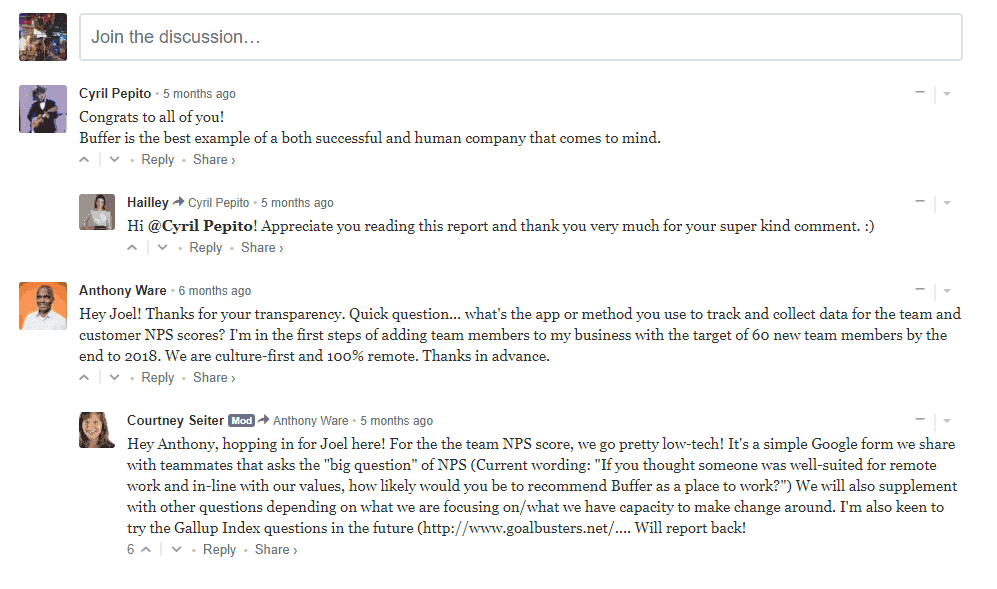
Just take a look at the comments on any of their company updates. They’re chock full of other startup founders who are reading them and engaging with the brand.
Word of caution: Link-building, manual penalties, and more
While Buffer has had incredible success and growth over the years, they did run into one serious issue.
In 2014, Buffer was hit with a manual penalty from Google, which tanked their organic traffic for a period of about two weeks.

Although it seems that the penalty was an error on Google’s side, which stemmed from Buffer migrating to an HTTPS domain, this is still a good time to talk about some of the more unpredictable parts of SEO and traffic growth.
Buffer was able to recover, but it did cost them a decent chunk of short-term traffic and may have stunted their overall, long-term growth.
This illustrates what can happen to websites that don’t follow the rules or look for quick ways to hack their traffic. In 99.9% of cases (Buffer being a huge exception here, apparently), sites that are engaged in white-hat content marketing and SEO will never have to deal with these types of doomsday scenarios.
But that doesn’t mean it’s impossible. And sometimes, what seems to be “fair play” may end up pissing off Google and getting your site in trouble.
It’s important to know that link-building, in particular, can be a fickle art. Often times, we walk a fine line. But the key takeaway here is that pretty much any possible “hack” or shortcut to overnight SEO success either won’t work or will eventually get you penalized and actually hurt your traffic.
As with anything when it comes to content marketing, the key to building links (the right way) is to create a kickass resource and then show it to the right people. Earn genuine links from people who think that your content is valuable and link-worthy—you can’t go wrong.
No amount of gray- or black-hat tactics or get-links-quick schemes can make up for having shitty content or a lazy content promotion strategy.
Do the work. Get the results.
Key takeaways from Buffer’s content marketing strategy
It’s clear that Buffer has implemented a number of advanced tactics and strategies to help them achieve tremendous growth over the last 7 years.
This teardown is just another example of how critically important it is to have a well-developed content marketing strategy built on proven growth frameworks. No amount of “blog and pray” will give the kind of results that we’ve seen from Buffer.
Let’s recap the key findings from this teardown and specific steps you can take to apply these secrets to build a killer content marketing program.
- Use guest posts to help gain traction and brand awareness – When you have no audience, try to borrow someone else’s as much as possible
- Curate content to create value for readers – Not every piece of content has to be built from scratch; use what’s already been published
- Over-invest in advanced social media promotion to build your audience and drive traffic – Simply tweeting out an article once probably won’t move the needle
- Get more out of every piece of content by repurposing for different uses and channels – Find new and emerging platforms where you can share your content, put it into different formats to maximize effectiveness
- Tell authentic stories—even about yourself – People crave content that helps them understand and contextualize their own experiences
- Be cautious about questionable quick-wins that may get you in trouble – Black- and gray-hat SEO tactics almost never pay off in the long run
The biggest takeaway from this teardown should be that no one thing works on its own—and no tactic works forever.
Content marketing is a constantly evolving process. Both in terms of the landscape as a whole, as well as your company’s individual strategy. Things are changing every day and tactics that once worked may no longer generate results. As you grow and learn, you should be adapting to what is working and finding new ideas for how to drive growth.
Of course, the fundamentals will stay largely the same (remember: create kickass content; show it to the right people). The real secret is understanding the fundamentals well enough to identify new opportunities as they emerge.
That’s what’s made Buffer consistently successful over such a long period of time—and it’s how you can build a great content marketing strategy, too.
Hire a Team of Content & Growth Experts
The Optimist team is built to scale–and help companies scale, too. Full-service content marketing and SEO, proven growth frameworks, and decades of experience.
Get more kick-ass content from us
Subscribe to our email list and get regular updates.
No spam or BS. Just great, insightful articles.